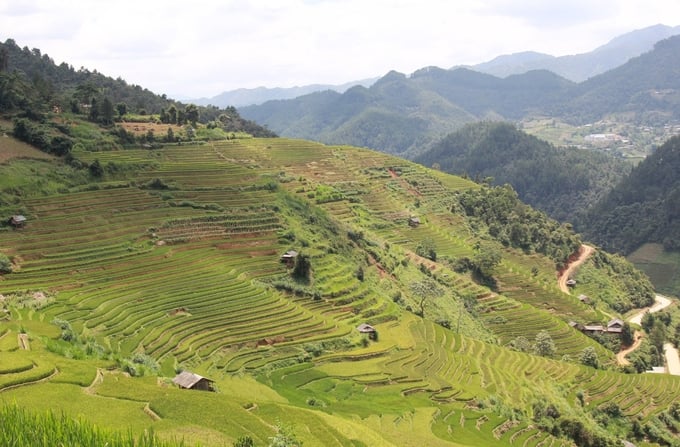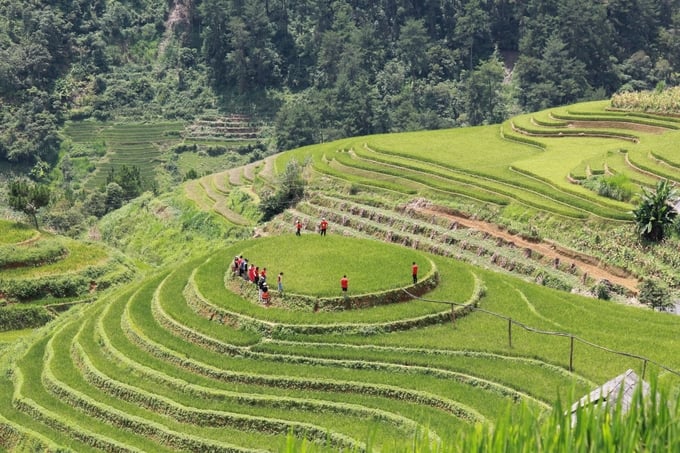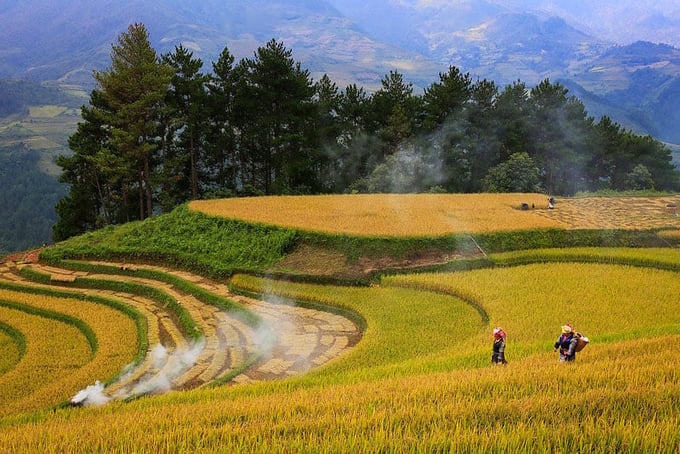November 27, 2025 | 21:56 GMT +7
November 27, 2025 | 21:56 GMT +7
Hotline: 0913.378.918
November 27, 2025 | 21:56 GMT +7
Hotline: 0913.378.918
The reporter came to Mu Cang Chai district (Yen Bai province) in the early days of autumn, when the weather in the lowlands was still hot and stuffy, but the air here was quite pleasant, it was chilly in the early morning, and by noon the sun was no longer harsh. All along the way, I felt the richness of nature and the unique cultural life of the Northwest ethnic people.
The road to Mu Cang Chai, although far and difficult, is very interesting. The scenery changes constantly on the way. Before we can see all the Thai people's stilt houses next to the vast Muong Lo field with countless white balconies, arrived on winding roads, winding on steep hillsides. From pass to pass, mountain to mountain, I can clearly feel the change in altitude, on both sides of the road are terraced fields that overwhelm people's hearts.

In Mu Cang Chai, there are more than 7,000 hectares of terraced fields created by highland people. Photo: Thanh Tien.
Mu Cang Chai has a unique climate, cool all year round, the average annual temperature ranges from 19 - 21 degrees Celsius. This place has countless beautiful, majestic and extremely poetic scenes. The most typical is the special national relic "Mu Cang Chai Rice Terraces Scenic Spot" - a masterpiece of the art of farming on sloping land that has been recognized by many prestigious travel magazines in Vietnam and the world as “one of the most dazzling destinations in the world”.
Mu Cang Chai terraced field complex has a total area of over 7,000 hectares, of which more than 850 hectares of core area has been recognized by the Prime Minister as a special National Monument in 2019, located in La Pan Tan, De Xu Phinh, Che Cu Nha, Kim Noi, Mo De and Lao Chai commune.
Mu Cang Chai terraced fields are closely associated with the lives and customs of the Mong people. Because of the lack of flat fields for cultivation, the Mong people have taken advantage of each small piece of field broken up on each mountain with an altitude of 800 - 1,700m above sea level. The act of conquering nature to survive has unintentionally turned the people here into "artists" who create a majestic "work of art" amidst the vast mountains.
According to experienced people, it is most beautiful to see the terraced fields at La Pan Tan raspberry hill in the morning. At that time, thin sheets of sunlight began to shine, intertwining with each other and spreading a mysterious mist. It feels like being lost in a promised land, walking in the middle of a vast yellow sea filled with white smoke. To take photos, any angle will give us stunningly beautiful photos, both illusory and romantic.

The Raspberry Hill area in La Pan Tan is always the place that attracts the most tourists to take photos. Photo: Thanh Tien.
Not only early morning, but the sunset here is also equally beautiful. The sunset on the raspberry hill has an extremely brilliant beauty, from the warm pink-yellow color, the sky gradually turns to a dreamy purple color and then descends into the sea of golden rice fields into a quiet, peaceful night. The rice flowers laden with grains also fall asleep, radiating a sweet fragrance, ecstatic tourists.

Dawn and sunset are the times that create the most brilliant photos. Photo: Provided by Artist Tuan Vu.
Photographic artist Nguyen Tuan Vu - Yen Bai Provincial Literature and Arts Association said that every year, we fellow photographers also come to Mu Cang Chai several times. We were especially attracted by the beauty of the Rice Terraces landscape. During the flood season (around May - June), the terraced fields have a wild, simple beauty with the main dark color scheme, true to the mountainous region of the Northwest.

Mong people cultivated rice. Photo: Provided by Artist Tuan Vu.
Ms. Luong Thi Xuyen - Vice Chairwoman of Mu Cang Chai District People's Committee wishes that in the future we will aim to request UNESCO to recognize Mu Cang Chai Rice Terraces as a world heritage site. Therefore, to continue to preserve and develop the Rice Terraces Scenic Area, the government and people in the district hope that the State will have a policy to support people directly growing rice in the relic area so that people feel secure in working in production and protection.
Translated by Bao Ngoc

(VAN) According to Mr. Vo Minh Thanh, Director of the Tay Ninh Department of Agriculture and Environment, Resolution 57 has created a new development pathway for the locality, shifting from traditional toward modern agriculture.
/2025/11/26/4909-2-154329_878.jpg)
(VAN) Pearl grouper farming in HDPE cages not only delivers economic efficiency but also contributes to protecting the environment, creating jobs, and promoting marine-based experiential tourism.

(VAN) The model of making a living under the forest canopy through the agroforestry system in Van Son commune, Bac Ninh province, is expected to generate an annual income of approximately VND 30 million/ha.

(VAN) Many enterprises in Can Tho are harnessing natural energy and reducing greenhouse gas emissions in their production processes, thereby contributing to the promotion of a sustainable green transition.
/2025/11/24/3536-2-112800_176.jpg)
(VAN) Dong Nai now has tens of thousands of hectares of forests certified for sustainable management, and this area will continue to be expanded in the coming period.

(VAN) Vinh Ha hamlet (Dai Xuyen commune, Hanoi) is shifting away from small-scale farming as households adopt bioscurity into their breeder chicken models.

(VAN) Heavy rains make aquatic species more vulnerable to disease. Proactive water management and high-tech systems help farmers prevent outbreaks and protect yields.